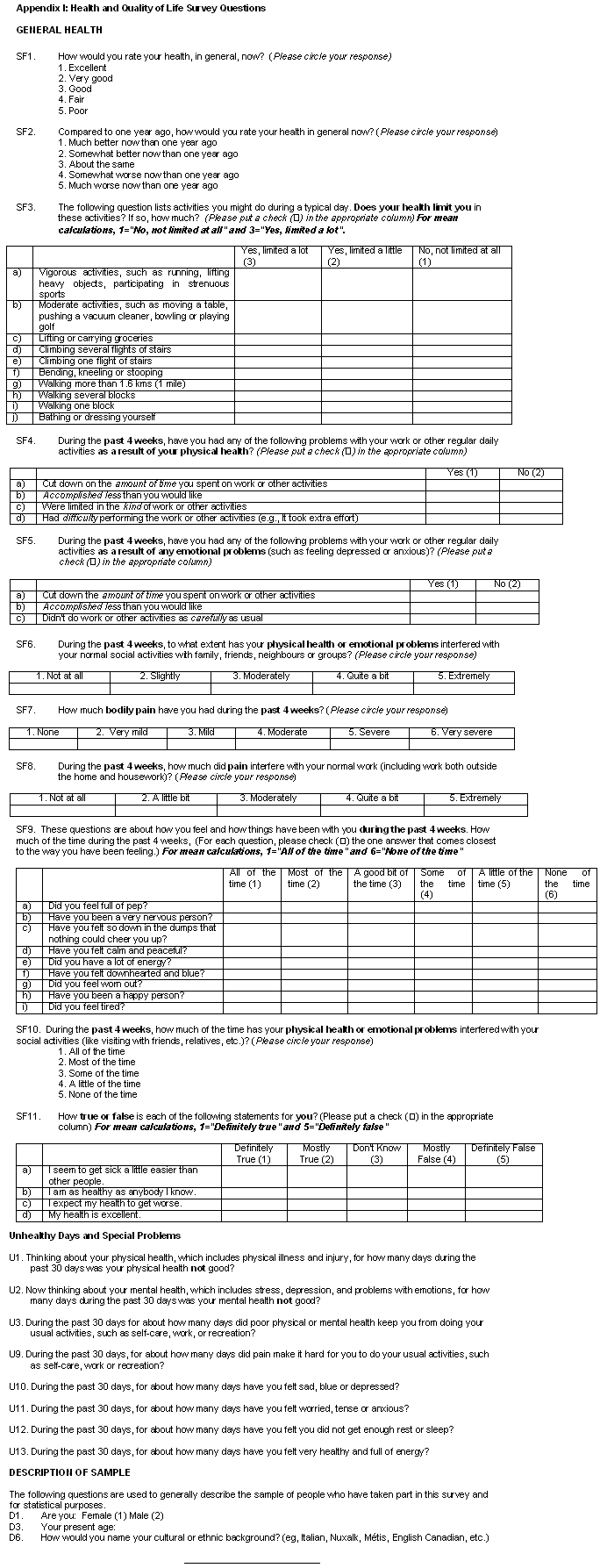Introduction
North American rural residents have higher rates of chronic disease and they report being ill more frequently compared with their urban counterparts1. These findings suggest rural populations are not as healthy as urban populations. Strictly speaking the term 'health' refers not simply to rates of disease and disability but also refers to a positive state of physical, mental and social wellbeing. Health-related quality of life survey questions have been developed to measure perceived discrepancies between one's expectations and one's actual physical, emotional, and social functioning - that is, one's subjective sense of health. Unfortunately, few if any, rural populations have been surveyed so little is known about how healthy rural residents perceive themselves to be1.
It is believed that better understanding of the relationship between health-related quality of life and chronic disease will also result in development of treatment strategies which preserve or improve function in every day life and preserve or improve health-related quality of life. It is also believed that improved health-related quality of life will lead to fewer office visits and hospitalizations and, hence, reduce healthcare costs2-4.
With respect to a chronic disease like diabetes mellitus, for example, this means that healthcare professionals should not just focus on objective vital signs (eg blood pressure), physical examination findings (eg retinopathy, nephropathy, heart disease), and laboratory tests (eg hemoglobin A1c values). Rather, healthcare professionals should strive to also understand the subjective impact diabetes and its management has on a diabetic's physical and mental functioning - that is, their health-related quality of life. Ideally patients should have both improved glycemic control and better health-related quality of life5.
We recently studied health-related quality in residents living in the isolated, rural community of Bella Coola, Canada6,7. Health-related quality of life was measured using the MOS 36-item Short Form Health Survey (SF-36), and the US Centers for Disease Control healthy day's items. Within the Bella Coola Valley population, age, Aboriginal status, and diabetes were all found to be associated with poorer self-reported health-related quality of life scores. Mean scores for Aboriginal people were lower/poorer than mean scores for non-Aboriginal people in all the quality of life questions. Mean scores for these type II diabetic people were also lower than mean scores for non-diabetics in all the quality of life questions. Aboriginal diabetics reported the worst scores of all on almost all of the health-related quality of life questions. The objective of this present study is to build on these initial findings by investigating the relationship between chronic disease and health-related quality of life in this rural patient population.
Methods
Description of community
The Bella Coola Valley is an isolated rural community located in the central coast region of British Columbia (Fig 1)8,9. According to the 2001 Census 2285 people live in the Bella Coola Valley, with 46% of these people estimated to be of Aboriginal descent 10,11. Bella Coola Valley is part of the traditional territory of the Nuxalk Nation, a tribe of Salish-speaking coastal Indians12-15.

Figure 1: Map of the study area.
Community participation
This research project has been carried out in a participatory fashion, following the recommendations outlined in a recently published policy statement entitled A Guide for Health Professionals Working with Aboriginal Peoples16. A goal of these recommendations is to make the relationship between Aboriginal people and non-Aboriginal healthcare providers a fair and honorable one16-18.
There was consultation with the Nuxalk Band Council, community members and local healthcare providers on our plans to study determinants of health and disease of people living in the Bella Coola valley. Dr Thommasen participated in potlatches asking for community support and explained the types of health projects we were planning to do. Prior to collecting data we obtained letters of support from the Nuxalk Band Council, from the Bella Coola Transitional Health Authority, and from Central Coast Regional District. Ethics approval to collect data was obtained from research ethics committees located at both the University of British Columbia, and at the University of Northern British Columbia. The results and the manuscript were reviewed and approved for publication by both Nuxalk Health professionals and United Church Health Services professionals.
Chart review details
Two retrospective reviews of clinic charts were conducted by HT. The first chart review was performed in July-August 2001 to determine an 'active' September 2001 clinic population. Names and addresses were tabulated onto an electronic spreadsheet and these were used for the mail-out health-related quality of life survey which was happening simultaneously.
The second detailed retrospective review of all clinic charts located in the Bella Coola Medical Clinic took place in the spring of 2003. Charts of patients on the September 2001 clinic population list were reviewed for the following information: age, sex, Aboriginal status; height and weight; and presence or absence of chronic disease. Aboriginal status for the study population was determined from multiple sources - Nuxalk Band lists, a locally available genealogy, clinic chart and from the survey6,19,20.
The presence of diabetes was based on a physician diagnosis of diabetes which, in turn, was based on the 1998 clinical practice guidelines for the management of diabetes in Canada21,22, and the presence or absence of the following chronic conditions: chronic obstructive pulmonary disease, hyperlipidemia, hypertension, coronary artery disease, depression/anxiety disorder, cancer, osteoarthritis, inflammatory arthritis and chronic back/neck pain. Definitions used for these chronic conditions have been reported elsewhere23.
Health-related Quality of Life Survey
A Health and Health Care Survey was offered to all adults living in the Bella Coola Valley between August 2001 and May 20026 . The aim of this investigation was to obtain some baseline self-reported data on the health status and overall quality of life of all residents of the Bella Coola Valley of British Columbia aged 17 years or older, and to measure the impact of a set of designated health determinants on their health and quality of life.
Health-related quality of life (HRQOL) was assessed in this study using Medical Outcomes Study Short Form 36-item health survey questions (SF-36)24-27, and Centers of Disease Control and Prevention (CDC) unhealthy day questions (Appendix I)3. Both are well established with good reliability, brevity, validity, responsiveness and comparability. Both were designed to evaluate aspects of functional status and subjective wellbeing.
The SF-36 scale works best as a health profile measure with eight dimensions, rather than as a single summative measure. The eight different health dimensions/health concepts evaluate the degree to which an individual's health limits or impairs: (i) physical functioning (PF; 10 items); (ii) social functioning (SF; 2 items); (iii) bodily pain (BP; 2 items); (iv) activities due to physical problems - role-physical (RP; 4 items); (v) activities due to emotional problems - role-emotional (RE; 3 items); (vi) emotional wellbeing - mental health (MH; 5 items); (vii) vitality (VT; 4 items); and (viii) general health (GH) perceptions (5 items). Domain scores for the SF-36 instrument were grouped and then computed following the protocol of Ware et al.24. The SF-36 scale scores range from 0 to 100, with higher scores indicating better functioning, wellbeing, and state of health.
The SF-36 questions were followed by 8 items from the United States Centers for Disease Control and Prevention, Behavioral Risk Factor Surveillance System (BRFSS) pertaining to number of unhealthy days and special limitations\problems3.
In the period from August to November 2001, a number of procedures were used to try to get every resident aged 17 years or older of the Bella Coola Valley of British Columbia to fill out the eleven-page questionnaire6. There were two mailings to all adults listed on the September 2001 clinic population list. Questionnaires were also distributed at the clinic, the emergency department of the Bella Coola Hospital, and in two local grocery stores. Booths were set up at the grocery stores and at the clinic where research assistants administered the questionnaire to people who might not normally respond to a mail-out survey, including elderly people and those with literacy problems. Questionnaires were also hand delivered on the local reserve and picked up later.
An identification number was given to each questionnaire sent out. A single investigator (HT) was the only one able to link this number to the 2001 clinic patient list. This information was used for the purposes of re-mailing, and for linking questionnaire responses to retrospective clinic chart review information. All recipients were asked to read an informed consent form or were read an informed consent form prior to completion of a questionnaire.
Statistical analysis
Chart and survey derived information was entered into an electronic spreadsheet (EXCEL), with names and addresses removed. Results were summarized using EXCEL. Formal data analysis was done with SPSS Windows software (SPSS Inc, Chicago, IL, USA). In all tests, a 0.05 level of significance was used.
One-way analysis of variance was used to compare the various demographic and chronic diseases with respect to each of the SF-36 domains and each of the unhealthy day's outcomes. Multiple regression analysis was then performed after controlling for age, sex and Aboriginal status28.
Results
A total of 675 useable health and health care surveys were returned. An estimated 1770 Bella Coola adult residents were eligible to complete this survey, so the estimated overall response to the survey was 38% (675/1770). Compared with the total clinic population, relatively more females (57% vs 49%), non-Aboriginals (63% vs 57%) and older people (48.9 vs 43.5 years) answered the survey (Table 1). The most prevalent chronic diseases among the survey respondents were hypertension (17%), depression/anxiety (13%), hyperlipidemia (11%), chronic back/neck pain (11%) and osteoarthritis (9%).
Table 1: Summary of clinic population and survey responders/non-responders
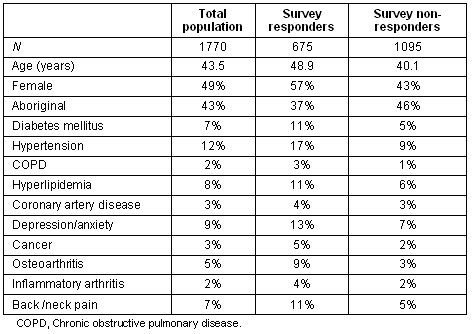
Demographic information for each chronic disease/disability variable studied is summarized (Table 2). With respect to diabetes, for example, the data reveal that the average age of diabetics is older than average of age of non-diabetics living in the Bella Coola Valley; the male to female ratio among diabetes is approximately 1 (ie 49% of diabetics are female and 51% diabetics are male); and proportionately more diabetics are Aboriginal (61%) compared with the non-diabetic population (34%).
Table 2: Chronic disease and demographic information
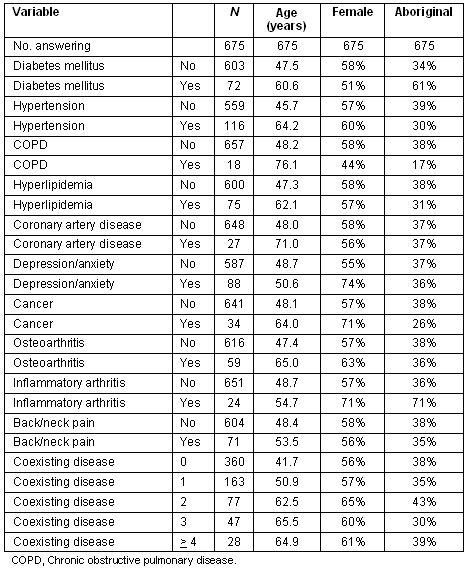
A description of co-morbidities associated with each chronic disease/disability variable is summarized (Table 3). The data show, for example that 50% of people with diabetes also have hypertension and 31% of people with hypertension have diabetes. The most commonly listed coexisting chronic diseases in those people with four or more chronic diseases are diabetes (68%), hypertension (86%), hyperlipidemia (79%) and depression/anxiety (50%).
Table 3: Chronic disease co-morbidity
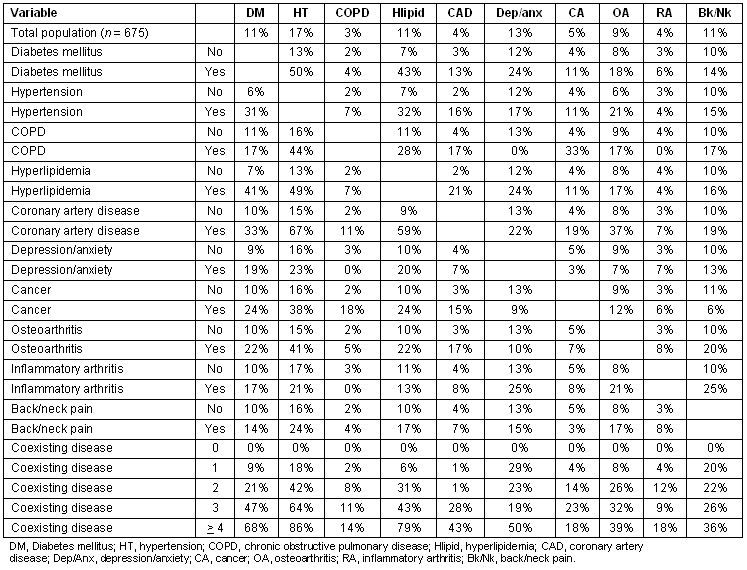
The relationship between demographic variables and average SF-36 domain scores are summarized (Table 4). A detailed statistical analysis of this information has already been performed and reported elsewhere6. The average SF-36 domain scores for each of the chronic diseases/illnesses studied are shown (Table 5), and a summary of the statistical analyses of this data are also shown (Tables 6,7). For most of the chronic diseases studied, the presence of chronic illness is associated with significant worsening of HRQOL item scores, even after correcting for age, sex and Aboriginal status. In addition, we also found that the greater the number of coexisting chronic disease the worse the HRQOL item score.
Table 4: Demographic information and average SF-36 domain scores
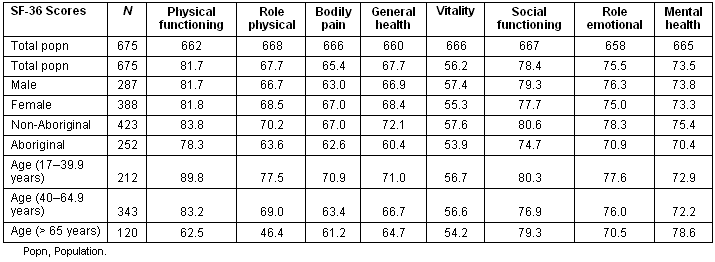
Table 5: Chronic disease and average SF-36 domain scores
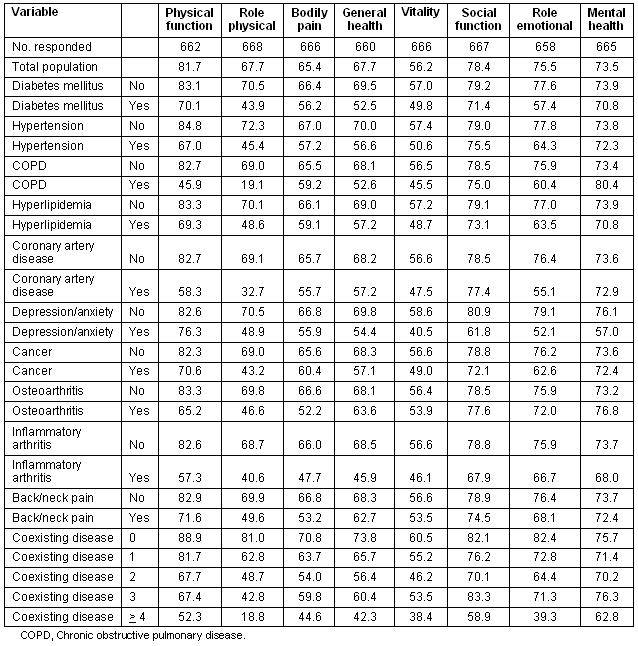
Table 6: Summary of SF-36 one-way ANOVA analysis
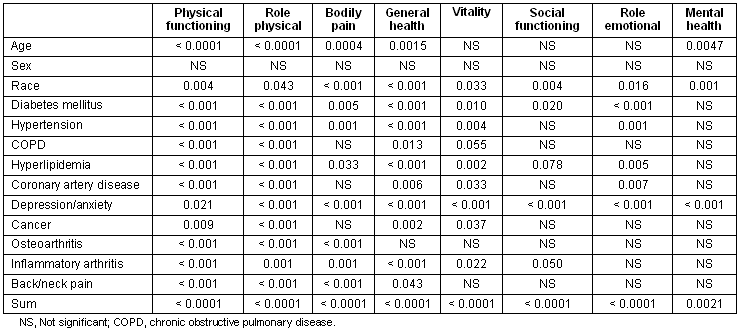
Table 7: Regression analysis of SF-36 scores after controlling for age, sex, race
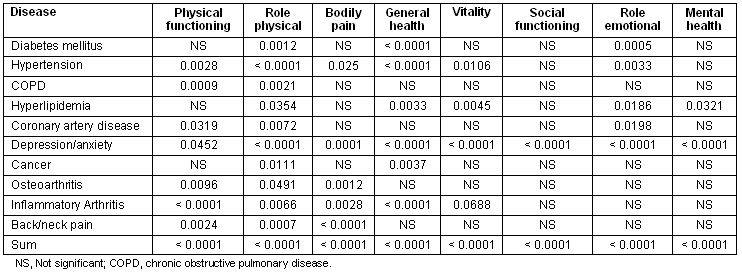
The relationship between each demographic variable studied and the average number of healthy days for each healthy days item studied is summarized (Table 8). A detailed statistical analysis of this information has also already been performed and reported elsewhere6. The average number of healthy days for each healthy day item scores for each of the chronic diseases/illnesses studied are shown (Table 9), and a summary of the statistical analyses of these data are shown (Tables 10,11). For most of the chronic diseases studied, the presence of chronic illness is associated with significant increases in the number of unhealthy days and significant decreases in the number of healthy days, even after correcting for age, sex and Aboriginal status. In addition, we also found that the greater the number of coexisting chronic disease the greater the number of unhealthy days, and the fewer the number of healthy days reported.
Table 8: Demographic information and healthy day items

Table 9: Chronic disease and average healthy days item scores
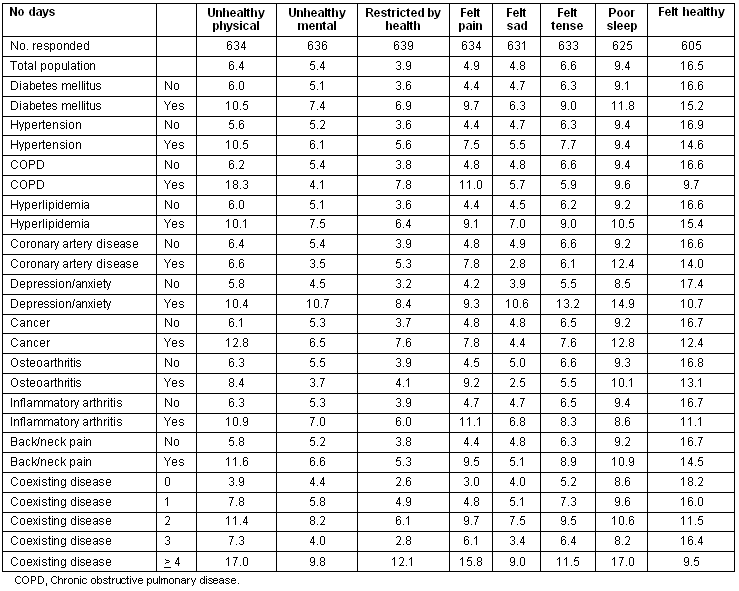
Table 10: Summary of healthy days one-way ANOVA analysis
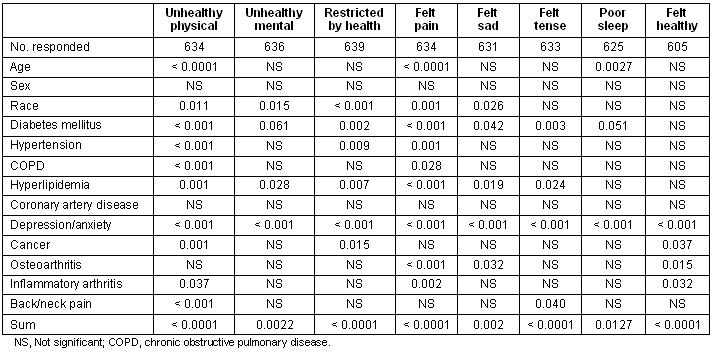
Table 11: Regression analysis of healthy days scores after controlling for age, sex, race
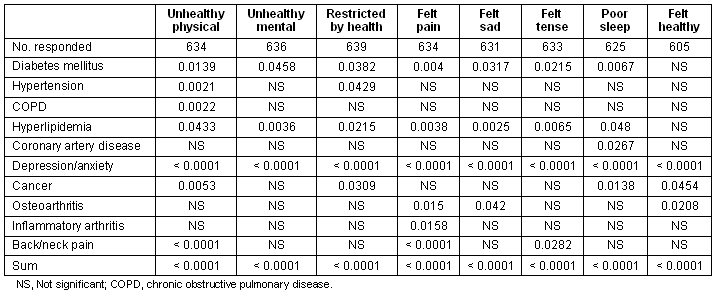
Discussion
At the present time, health data is not routinely collected or analyzed at the rural community level in Canada, so no-one really knows which communities are 'sickest', or which factors are responsible for poor community health. We believe that communities need to have a clearer picture of the health problems they are facing before they can make changes. This study demonstrates that it is possible to calculate rural community prevalence rates for a number of different diseases and disabilities by simply reviewing clinic charts. This information can be used to explore relationships between chronic disease and subjective sense of health at the rural community level.
We found that increasing number of coexisting chronic disease was a powerful predictor of poor health-related quality of life as measured using the Medical Outcomes Study Short Form 36-item health survey (SF-36) questions and the CDC unhealthy day questions. All the chronic diseases studied impacted at least some of the HRQOL items studied and the impacts made sense for the most part. For example, people with depression/anxiety were more likely to report lower scores on mental health related items - for example, SF-36 mental health, unhealthy mental days, SF-36 role-emotion, SF-36 social functioning, unhealthy mental days, and number of days feeling sad or tense. People with arthritis were more likely to report lower physical health related items - for example, SF-36 physical health, SF-36 role physical, SF-36 bodily pain, and feeling pain days.
Our findings are consistent with those from studies which have explored the relationship between HRQOL and specific chronic illnesses2,29-35. Stewart2 reported that for eight of nine common chronic medical conditions, patients with the chronic condition showed markedly worse physical, role, and social functioning, mental health, health perceptions, and/or bodily pain compared with patients with no chronic conditions. A number of studies assessing HRQOL in diabetics have shown that lower HRQOL scores are associated with worsening severity of complications/comorbidity29-35. Ahroni examined the relationship between SF-36 domain scores and over 25 diabetic complication characteristics (eg eye changes, poor vision, laser photocoagulation, high blood pressure, stroke, angina, heart attack, kidney disease, proteinuria, dialysis, circulation problem, claudication, numbness, foot ulceration, amputation) and found that an increase of greater than one diabetes complication characteristic was associated with an average loss of 7.2 to 11.8 points on six SF-36 scales (GH, PF, SF, RP, BP, VT)34. Renal and neuropathy complications have the greatest effects on the SF-36. Woodcock summarized HRQOL survey responses of 131 type 2 diabetics and found that people with illness related to or unrelated to diabetes scored significantly lower on most SF36 dimensions - physical functioning, physical role limitation, vitality, general health, mental health, social functioning, emotional role limitation35.
Lloyd studied an even larger number of type 2 diabetics (n = 1233) and found that the presence of even mild diabetic complications had a significant impact on all the SF-36 domains - especially the physical ones; that is, physical functioning, role physical, bodily pain, general health. A theoretical implication of such findings is that aggressive management of blood sugar, blood pressure, cholesterol, and even depression, in diabetes will not only prevent the development of diabetic complications but will also prevent irreversible deteriorations in HRQOL29,30,36,37.
Some studies suggest hypertension does not have a significant impact SF-36 domains and this has been attributed to the fact that hypertension is asymptomatic in the majority of patients2,33. Table 5, however, reveals that in our patient population a high proportion of people with hypertension have coexisting chronic disease and, we believe, this probably accounts for the significant differences found between hypertensive and non-hypertensive HRQOL scores. Bardage et al. studied 5404 Swedish people with and without hypertension and they also found that hypertensive people scored lower in most of the eight SF-36 domains than those without hypertension even after controlling for age, sex, sociodemographic factors and comorbidity38. Presence of diabetes and angina pectoris was associated with even lower SF-36 scores.
There are some limitations in this study. Not everyone living in the valley completed the health questionnaire. However we did calculate prevalence rates by reviewing all clinic charts, so it is known how much the survey prevalence rates differ from the overall clinic recorded prevalence. The generalizability of the study is also an issue, because the Bella Coola Valley is a rural, remote community with over 40% of the residents being of Aboriginal descent. Another limitation to our study is that we did not include diseases such as stroke, blindness, end-stage renal disease, or congestive heart failure which presumably also have an impact on HRQOL30,39. Also we did not look at others things which can impact HRQOL - for example, marital status, education, physical activity levels, obesity or income30,35,37,39,40.
Conclusion
People living in the rural remote community of Bella Coola who have chronic disease experience significant impairment in their health-related quality of life. The greater the number of coexisting chronic diseases a person has, the more likely that poor HRQOL scores will be reported. Healthcare administrators should realize that higher rates of chronic disease/illness reported for rural populations also implies greater subjective suffering among these people.
Acknowledgements
We wish to acknowledge the staff at the Bella Coola Medical Clinic for survey assistance. Dr Thommasen would like to acknowledge the Community-Based Clinician-Investigator Program for financial support.
References
1. Thommasen HV, Tatlock J, Elliott R, Zhang W, Sheps S. Review of Salaried Physician visits in a remote community - Bella Coola Valley. Canadian Journal of Rural Medicine 2006; 11: 23-31.
2. Stewart AL, Greenfied S, Hays RD, Wells K, Rogers WH, Berry SD et al. Functional status and well-being of patients with chronic conditions. Journal of the American Medical Association 1989; 262: 907-913.
3. Centers for Disease Control and Prevention (CDC). Measuring healthy days: Population assessment of health-related quality of life. Atlanta, GA: CDC, 2000; 40.
4. Michalos AC, Zumbo BD, Hubley A. Health and the quality of life. Social Indicators Research 2000; 51: 245-286.
5. Weinberger M, Kirkman MS, Samsa GP, Cowper PA, Shortliffe A, Simel DL et al. The relationship between glycemic control and health-related quality of life in patients with non-insulin-dependent diabetes mellitus. Medical Care 1994; 29: 1173-1181.
6. Michalos AC, Thommasen HV, Anderson N, Zumbo B. Determinants of health and the quality of life in the Bella Coola Valley. Social Indicators Research 2005; 72: 1-50.
7. Thommasen HV, Thommasen AT, Berkowitz J, Michalos AC. Understanding relationships between diabetes mellitus and health-related quality of life in a rural community. Rural and Remote Health 5: 441 (Online 2005). Avaliable: http://rrh.org.au (Accessed 31 May 2006).
8. Thommasen HV, Patenaude J, McArthur A, Tildesley H. Diabetes related Disorders and Diseases among Aboriginal and Other People Living in the Bella Coola Valley. Rural and Remote Health Journal 4: 319 (Online) 2004. Available from: http://rrh.org.au (Accessed 31 May 2006).
9. Thommasen HV, Newbery P, Watt WD. Medical history of central coast of British Columbia. British Columbia Medical Journal 1999; 41: 464-470.
10. BC Ministry of Management Services. PEOPLE 27. BC Stats. PO Box 9410 Stn Prov Govt, Victoria, BC Canada.
11. British Columbia Vital Statistics Agency. 2001 British Columbia census. Victoria, BC: Government of British Columbia, 2003.
12. Kennedy DID, Bouchard RT. Bella Coola Indians. In: W Suttles (Ed.). Handbook of North American Indians. Washington: Smithsonian Institute, 1990; 323-339.
13. McIlwraith TF. The Bella Coola Indians. Toronto: University of Toronto Press, 1992.
14. Thommasen HV. Prehistoric medicine on BC's central coast. British Columbia Medical Journal 1999; 41: 343-346.
15. Acheson S. Culture, contact, demography and health among the Aboriginal peoples of British Columbia. In: A persistent spirit: towards understanding aboriginal health in British Columbia. PH Stephenson, SJ Elliott, LT Foster, J Harris (Eds). Canadian Western Geographical Series, Volume 31. University of Victoria, Victoria: Western Geographical Press, 1995; 1-42.
16. Smylie J (Aboriginal Health Issues Committee). A guide for health professionals working with Aboriginal peoples: Health Issues affecting Aboriginal peoples. Journal of the Society of Obstetricians and Gynecologists 2001; 100: 54-68.
17. Cave AJ, Ramsden VR. Hypothesis: The research page. Participatory action research. Canadian Family Physician 2002; 48: 1671-1672.
18. Macaulay AC, Gibson N, Freeman W, Commanda L, McCabe M, Robbins C et al. Participatory research maximizes community and lay involvement. BMJ 1999; 319: 774-778.
19. Thommasen HV, MacKenzie T, Klein MC, Lynch N, Reyes R, Grzybowski S.
Bella Coola Hospital obstetric maternal outcomes: 1940 to 2001. Canadian Journal of Rural Medicine 2005; 10: 13-21.
20. British Columbia Provincial Health Officer. A report on the health of British Columbians: Provincial Health Officer's Annual Report 2001. Feature report: the health and well-being of Aboriginal people in British Columbia. Victoria (BC): Ministry of Health and Ministry Responsible for Seniors, 2002.
21. Meltzer S, Leiter L, Daneman D, Gerstein HC, Lau D, Ludwig S et al. 1998 clinical practice guidelines for the management of diabetes in Canada. Canadian Medical Association Journal 1998; 159(Suppl 8): S1-S29.
22. Canadian Diabetes Association. 2003 Clinical practice guidelines for the prevention and management of diabetes in Canada. Canadian Journal of Diabetes 2003; 27(Suppl 2): S1-S152. Available: http://www.diabetes.ca/cpg2003/ (Accessed 31 May 2006).
23. Voaklander DC, Thommasen HV, Michalos AC. The relationship between health survey and medical chart review results in a rural population. Social Indicators Research 2006; (in press).
24. Ware JE, Snow KK, Kosinski M, Gandek B. SF-36 Health Survey: Manual and Interpretation Guide. Boston, MA: The Health Institute, New England Medical Center, 1993.
25. Ware JE, Sherbourne CD. The MOS 36-Item Short-Form health survey (SF-36): I. Conceptual framework and item selection. Medical Care 1992; 30: 473-483.
26. McHorney CA, Ware JE, Raczek AE. The MOS 36-Item Short-Form health survey (SF-36): II. Psychometric and clinical tests of validity in measuring physical and mental health constructs. Medical Care 1993; 31: 247-263.
27. McHorney CA, Ware JE, Lu JFR, Sherbourne CD. The MOS 36-Item Short-Form health survey (SF-36): III Tests of data quality, scaling assumptions, and reliability across diverse patient groups. Medical Care 1994; 32: 40-66.
28. Snedecor GW, Cochran WG. Statistical methods, 7th edn. Ames, IA: Iowa State University Press, 1980.
29. Martinez-Castelao A, Gorriz JL, Garcia-Lopez F, Lopez-Revuelta K, De Alvaro F, Cruzado JM. Perceived health-related quality of life and comorbidity in diabetic patients starting dialysis (CALVIDIA study). Journal of Nephrology 2004; 17: 544-551.
30. Jacobson AM, Samson JA, de Groot M. The evaluation of two measures of quality of life in patients with type I and type II diabetes. Diabetes Care 1994; 17: 267-274.
31. Edelman D, Olsen MK, Dudley TK, Harris AC, Oddone EZ. Impact of diabetes screening on quality of life. Diabetes Care 2002; 25: 1022-1026.
32. UK Prospective Diabetes Study Group. Quality of life in type 2 diabetic patients is affected by complications but not by intensive policies to improve blood glucose or blood pressure control (UKPDS 37). Diabetes Care 1999; 22: 1125-1136.
33. Lloyd A, Sawyer W, Hopkinson P. Impact of long-term complications on quality of life in patients with type 2 diabetes not using insulin. Value in Health 2001; 4: 392-400.
34. Ahroni JH, Boyko EJ. Responsiveness of the SF-36 among veterans with diabetes mellitus. Journal of Diabetes and its Complications 2000; 14: 31-39.
35. Woodcock AJ, Julious SA, Kinmonth AL, Campbell MJ. Problems with the performance of the SF-36 among people with type 2 diabetes in general practice. Quality of Life Research 2001; 10: 661-670.
36. Diabetes Control and Complications Trial (DCCT) Research Group. The effect of intensive treatment of diabetes on the development and progression of long-term complications in insulin-dependent diabetes mellitus. New England Journal of Medicine 1993; 329: 977-986.
37. UK Prospective Diabetes Study (UKPDS) Group. Effect of intensive blood-glucose control with metforminon complications in overweight patients with type 2 diabetes (UKPDS 34). Lancet 1998; 352(9131): 854-865.
38. Bardage C, Isacson DGL. Hypertension and health-related quality of life: an epidemiological study in Sweden. Journal of Clinical Epidemiology 2001; 54: 172-181.
39. Klein BEK, Kelin R, Moss SE. Self-rated health and diabetes of long duration: the Wisconsin Epidemiologic Study of Diabetic Retinopathy. Diabetes Care 1998; 21: 236-240.
40. Comacho F, Anderson RT, Bell RA, Goff DC Jr, Duren-Winfield V, Doss DD et al. Investigating correlates of health related quality of life in a low-income sample of patients with diabetes. Quality of Life Research 2002; 11: 783-796.
Abstract
Introduction:
North American rural residents have higher rates of chronic disease and they report being ill more frequently compared to their urban counterparts. We recently studied health-related quality in residents living in the isolated, rural community of Bella Coola, Canada. Objective: to assess health-related quality of life parameters in adults suffering from chronic disease and living in the rural, remote community of Bella Coola.Methods: Design, mixed methods: (1) mailed health-related survey; (2) retrospective chart review. Study population: people aged 17 years and older living in the Bella Coola Valley and having a chart at the Bella Coola Medical Clinic as of September 2001 were asked to complete a detailed health-related quality of life survey during the period August to December 2001. Main outcome measures: demographics (age, sex, weight [BMI], ethnicity). Health-related quality of life was measured using the MOS 36-item Short Form Health Survey (SF-36), and the US Centers for Disease Control healthy day's items. Chronic diseases studied included diabetes mellitus, hypertension, chronic obstructive lung disease, coronary artery disease, hyperlipidemia, depression/anxiety, cancer, osteoarthritis, inflammatory arthritis and chronic back/neck pain.
Results: Response rate to the survey was 38% (675/1770). Compared to total clinic population relatively more female (57% vs 49%), non-Aboriginal (63% vs 57%) and older people (48.9 vs 43.5 years) answered the survey. The most prevalent chronic diseases among the survey respondents were hypertension (17%), depression/anxiety (13%), hyperlipidemia (11%), chronic back/neck pain (11%), and osteoarthritis (9%). Linear regression analysis was performed for each of the SF-36 domains and CDC healthy day items. The presence of chronic disease is associated with significant differences in HRQOL item scores and the greater the number chronic diseases present the worse the HRQOL item scores.
Conclusion: People living in the rural remote community of Bella Coola who have chronic disease experience significant impairment in their health-related quality of life. The greater the number of coexisting chronic diseases a person has, the more likely that poor HRQOL scores will be reported.
Key words: Aboriginal research, diabetes mellitus.
You might also be interested in:
2011 - Barriers to the up-take of telemedicine in Australia - a view from providers
2008 - Establishing standards for obstructed labour in a low-income country


